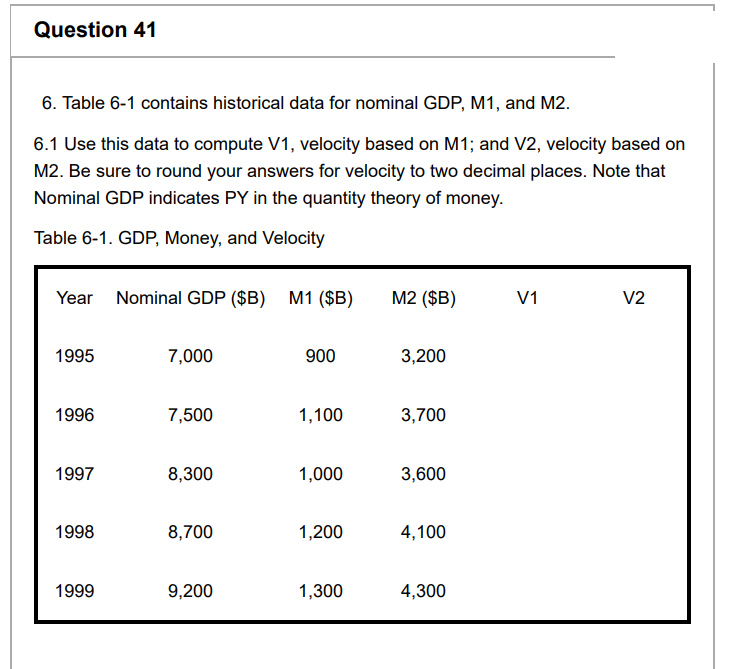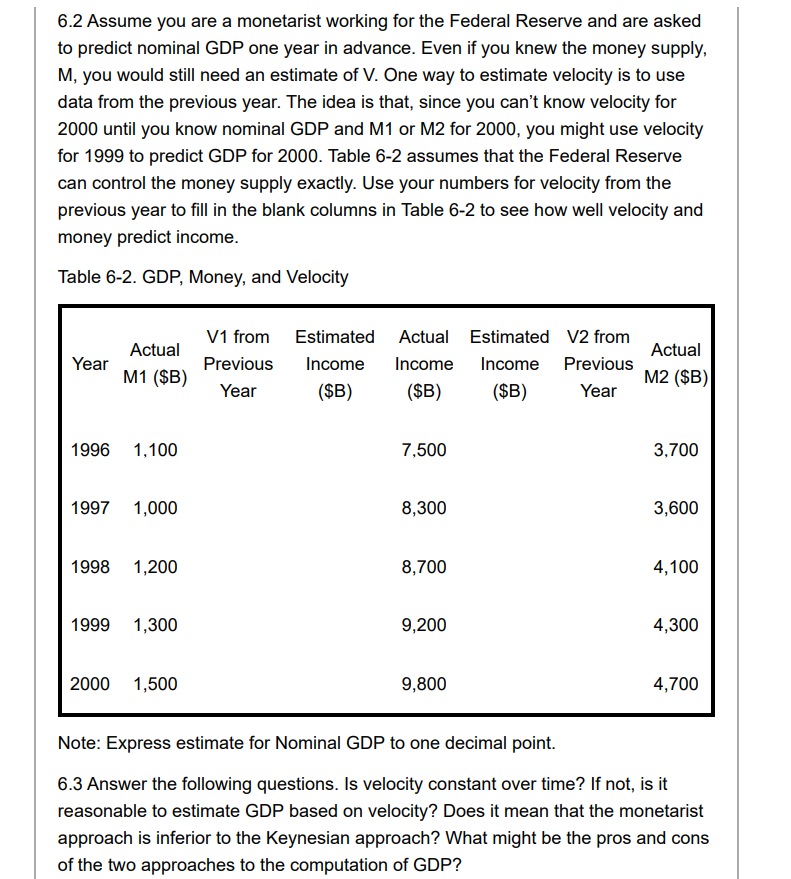6. Table 6-1 contains historical data for nominal GDP, M1, and M2. 6.1 Use this data to compute V1, velocity based on M1; and V2, velocity based on M2. Be sure to round your answers for velocity to two decimal places. Note that Nominal GDP indicates PY in the quantity theory of money. Table 6-1. GDP, Money, and Velocity Year Nominal GDP ($B) M1 ($B) 1995 1996 1997 1998 1999 7,000 7,500 8,300 8,700 9,200 900 1,100 1,000 1,200 1,300 M2 ($B) 3,200 3,700 3,600 4,100 4,300 V1 V2
6. Table 6-1 contains historical data for nominal GDP, M1, and M2. 6.1 Use this data to compute V1, velocity based on M1; and V2, velocity based on M2. Be sure to round your answers for velocity to two decimal places. Note that Nominal GDP indicates PY in the quantity theory of money. Table 6-1. GDP, Money, and Velocity Year Nominal GDP ($B) M1 ($B) 1995 1996 1997 1998 1999 7,000 7,500 8,300 8,700 9,200 900 1,100 1,000 1,200 1,300 M2 ($B) 3,200 3,700 3,600 4,100 4,300 V1 V2
Macroeconomics: Principles and Policy (MindTap Course List)
13th Edition
ISBN:9781305280601
Author:William J. Baumol, Alan S. Blinder
Publisher:William J. Baumol, Alan S. Blinder
Chapter15: The Debate Over Monetary And Fiscal Policy
Section: Chapter Questions
Problem 2TY
Related questions
Question

Transcribed Image Text:Question 41
6. Table 6-1 contains historical data for nominal GDP, M1, and M2.
6.1 Use this data to compute V1, velocity based on M1; and V2, velocity based on
M2. Be sure to round your answers for velocity to two decimal places. Note that
Nominal GDP indicates PY in the quantity theory of money.
Table 6-1. GDP, Money, and Velocity
Year Nominal GDP ($B) M1 ($B)
1995
1996
1997
1998
1999
7,000
7,500
8,300
8,700
9,200
900
1,100
1,000
1,200
1,300
M2 ($B)
3,200
3,700
3,600
4,100
4,300
V1
V2

Transcribed Image Text:6.2 Assume you are a monetarist working for the Federal Reserve and are asked
to predict nominal GDP one year in advance. Even if you knew the money supply,
M, you would still need an estimate of V. One way to estimate velocity is to use
data from the previous year. The idea is that, since you can't know velocity for
2000 until you know nominal GDP and M1 or M2 for 2000, you might use velocity
for 1999 to predict GDP for 2000. Table 6-2 assumes that the Federal Reserve
can control the money supply exactly. Use your numbers for velocity from the
previous year to fill in the blank columns in Table 6-2 to see how well velocity and
money predict income.
Table 6-2. GDP, Money, and Velocity
Year
Actual
M1 ($B)
1996 1,100
1997 1,000
1998 1,200
1999 1,300
2000 1,500
V1 from
Previous
Year
Estimated Actual Estimated V2 from
Income Income
Income Previous
($B)
($B)
($B)
Year
7,500
8,300
8,700
9,200
9,800
Actual
M2 ($B)
3,700
3,600
4,100
4,300
4,700
Note: Express estimate for Nominal GDP to one decimal point.
6.3 Answer the following questions. Is velocity constant over time? If not, is it
reasonable to estimate GDP based on velocity? Does it mean that the monetarist
approach is inferior to the Keynesian approach? What might be the pros and cons
of the two approaches to the computation of GDP?
Expert Solution
This question has been solved!
Explore an expertly crafted, step-by-step solution for a thorough understanding of key concepts.
Step by step
Solved in 3 steps

Knowledge Booster
Learn more about
Need a deep-dive on the concept behind this application? Look no further. Learn more about this topic, economics and related others by exploring similar questions and additional content below.Recommended textbooks for you

Macroeconomics: Principles and Policy (MindTap Co…
Economics
ISBN:
9781305280601
Author:
William J. Baumol, Alan S. Blinder
Publisher:
Cengage Learning



Macroeconomics: Principles and Policy (MindTap Co…
Economics
ISBN:
9781305280601
Author:
William J. Baumol, Alan S. Blinder
Publisher:
Cengage Learning



Principles of Economics 2e
Economics
ISBN:
9781947172364
Author:
Steven A. Greenlaw; David Shapiro
Publisher:
OpenStax

Brief Principles of Macroeconomics (MindTap Cours…
Economics
ISBN:
9781337091985
Author:
N. Gregory Mankiw
Publisher:
Cengage Learning

Essentials of Economics (MindTap Course List)
Economics
ISBN:
9781337091992
Author:
N. Gregory Mankiw
Publisher:
Cengage Learning